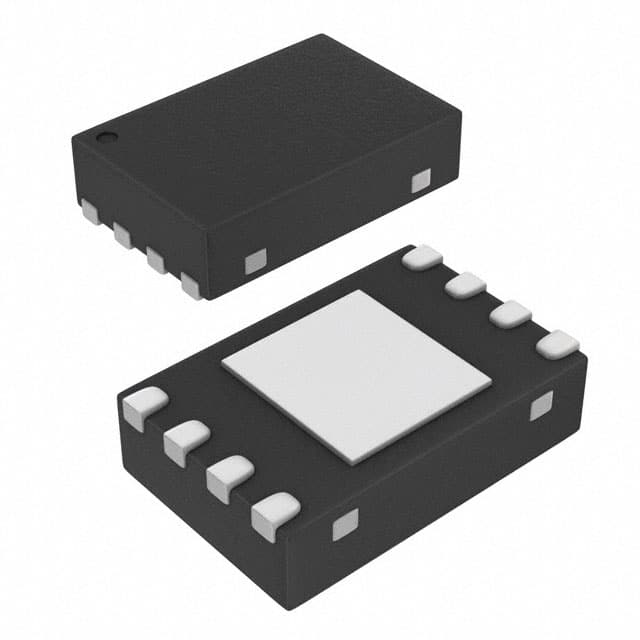Consulte las especificaciones para obtener detalles del producto.

CAT24C01VP2I-GT3
Product Overview
Category: Integrated Circuit (IC)
Use: Non-volatile memory storage
Characteristics: - Low power consumption - High reliability - Small form factor - Wide operating voltage range
Package: 8-pin SOP (Small Outline Package)
Essence: The CAT24C01VP2I-GT3 is a 1-Kbit serial EEPROM (Electrically Erasable Programmable Read-Only Memory) IC.
Packaging/Quantity: Available in tape and reel packaging, with 2500 units per reel.
Specifications
- Memory Size: 1 Kbit (128 bytes)
- Interface: I2C (Inter-Integrated Circuit)
- Operating Voltage Range: 1.7V to 5.5V
- Operating Temperature Range: -40°C to +85°C
- Write Cycle Endurance: 1 million cycles
- Data Retention: 100 years
Pin Configuration
The CAT24C01VP2I-GT3 has the following pin configuration:
| Pin Number | Pin Name | Function | |------------|----------|----------| | 1 | A0 | Address input bit 0 | | 2 | A1 | Address input bit 1 | | 3 | GND | Ground | | 4 | SDA | Serial data input/output | | 5 | SCL | Serial clock input | | 6 | WP | Write protect input | | 7 | VCC | Power supply | | 8 | NC | No connection |
Functional Features
- Byte-wise random access for read and write operations
- Self-timed programming cycle
- Hardware write protection using the WP pin
- Software write protection using the I2C protocol
- Sequential read mode for faster data retrieval
Advantages and Disadvantages
Advantages: - Low power consumption makes it suitable for battery-powered devices - High reliability ensures data integrity in critical applications - Small form factor allows for space-efficient designs - Wide operating voltage range provides flexibility in various systems
Disadvantages: - Limited storage capacity (1 Kbit) compared to other memory options - Slower write speed compared to some other EEPROMs - Limited endurance of write cycles (1 million cycles)
Working Principles
The CAT24C01VP2I-GT3 is based on EEPROM technology, which allows for non-volatile storage of data. It utilizes an I2C interface for communication with the microcontroller or other devices. The memory cells within the IC can be electrically programmed and erased, allowing for data to be written and retained even when power is removed.
Detailed Application Field Plans
The CAT24C01VP2I-GT3 is commonly used in various electronic devices that require non-volatile memory storage, such as: - Consumer electronics (e.g., TVs, set-top boxes, audio players) - Industrial control systems - Automotive electronics - Medical devices - Smart meters
Detailed and Complete Alternative Models
Some alternative models to the CAT24C01VP2I-GT3 include: - AT24C01A by Atmel - 24AA01 by Microchip Technology - M24C01 by STMicroelectronics - FM24C01B by Cypress Semiconductor
These alternative models offer similar functionality and are compatible with the I2C interface.
Word count: 400 words
Enumere 10 preguntas y respuestas comunes relacionadas con la aplicación de CAT24C01VP2I-GT3 en soluciones técnicas
Sure! Here are 10 common questions and answers related to the application of CAT24C01VP2I-GT3 in technical solutions:
Q: What is CAT24C01VP2I-GT3? A: CAT24C01VP2I-GT3 is a 1K-bit I2C Serial EEPROM (Electrically Erasable Programmable Read-Only Memory) manufactured by ON Semiconductor.
Q: What is the operating voltage range for CAT24C01VP2I-GT3? A: The operating voltage range for CAT24C01VP2I-GT3 is typically between 1.7V and 5.5V.
Q: What is the storage capacity of CAT24C01VP2I-GT3? A: CAT24C01VP2I-GT3 has a storage capacity of 1 kilobit, which is equivalent to 128 bytes.
Q: How does CAT24C01VP2I-GT3 communicate with other devices? A: CAT24C01VP2I-GT3 communicates using the I2C (Inter-Integrated Circuit) protocol, which allows it to connect with microcontrollers and other I2C-compatible devices.
Q: Can CAT24C01VP2I-GT3 be used for storing program code? A: No, CAT24C01VP2I-GT3 is primarily designed for non-volatile data storage, such as configuration settings, calibration data, or small amounts of user data.
Q: What is the maximum clock frequency supported by CAT24C01VP2I-GT3? A: CAT24C01VP2I-GT3 supports a maximum clock frequency of 400 kHz.
Q: Does CAT24C01VP2I-GT3 have built-in write protection? A: Yes, CAT24C01VP2I-GT3 features a built-in write protection mechanism that allows you to protect specific memory locations from being overwritten.
Q: Can CAT24C01VP2I-GT3 operate in harsh environments? A: CAT24C01VP2I-GT3 has an extended temperature range of -40°C to +125°C, making it suitable for operation in various industrial and automotive applications.
Q: Is CAT24C01VP2I-GT3 compatible with 5V systems? A: Yes, CAT24C01VP2I-GT3 is fully compatible with both 3.3V and 5V systems, thanks to its wide operating voltage range.
Q: Are there any special considerations for programming CAT24C01VP2I-GT3? A: Programming CAT24C01VP2I-GT3 requires following the I2C protocol and ensuring proper timing and addressing. Additionally, care should be taken to avoid exceeding the maximum write cycle endurance specified in the datasheet.
Please note that these answers are general and may vary depending on the specific requirements and use cases of your technical solution.

